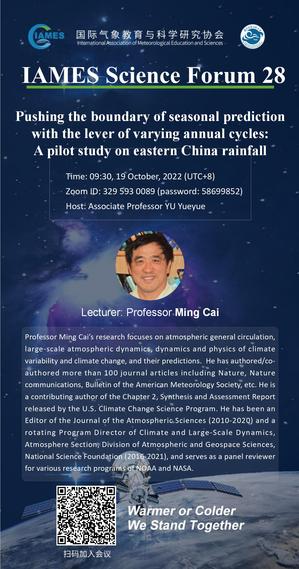报告题目:Pushing the boundary of seasonal prediction with the lever of varying annual cycles: A pilot study on eastern China rainfall
以变化的年循环为杠杆突破季节预测极限
时间:2022年10月19日 09:30
Zoom ID: 329 593 0089 (密码:58699852)
主讲人:Ming Cai 教授
主持人:虞越越 副教授
主讲人简介:
Professor Ming Cai’s research focuses on atmospheric general circulation, large-scale atmospheric dynamics, dynamics and physics of climate variability and climate change, and their predictions. He has authored/co-authored more than 100 journal articles including Nature, Nature communications, Bulletin of the American Meteorology Society, etc. He is a contributing author of the Chapter 2, Synthesis and Assessment Report released by the U.S. Climate Change Science Program. He has been an Editor of the Journal of the Atmospheric Sciences (2010-2020) and a rotating Program Director of Climate and Large-Scale Dynamics, Atmosphere Section, Division of Atmospheric and Geospace Sciences, National Science Foundation (2016-2021), and serves as a panel reviewer for various research programs of NOAA and NASA.
报告简介:
Predicting climate anomalies months in advance is of tremendous socioeconomic value. Facing both theoretical and practical constraints, this realm of “seasonal prediction” progressed slowly in recent decades. Here we devise an innovative scheme that pushes the boundary of seasonal prediction byrecognizing and isolating distinct spatiotemporal footprints left by modes of climate variability that cause varying annual cycles in response to the solar forcing. The predictive power harnessed from these spatiotemporal footprints results in a prediction skill surpassing existing models for seasonal forecasts of eastern China rainfall, which is one of the most challenging seasonal prediction problems. By considering varying annual cycles explicitly, the new scheme is able to predict multi-provincial flood and/or drought occurrences seamlessly over an entire year. This novel scheme is generically applicable for improving seasonal forecasts over other monsoon regions and for critical climate variables such as surface temperature and Arctic sea-ice extent.
